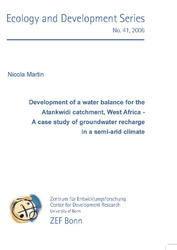| Departments | |
|---|---|
| Book Series (96) |
1378
|
| Nachhaltigkeit |
3
|
| Gesundheitswesen |
1
|
| Humanities |
2364
|
| Natural Sciences |
5406
|
| Mathematics | 229 |
| Informatics | 319 |
| Physics | 980 |
| Chemistry | 1363 |
| Geosciences | 131 |
| Human medicine | 243 |
| Stomatology | 10 |
| Veterinary medicine | 108 |
| Pharmacy | 147 |
| Biology | 835 |
| Biochemistry, molecular biology, gene technology | 121 |
| Biophysics | 25 |
| Domestic and nutritional science | 45 |
| Agricultural science | 1004 |
| Forest science | 201 |
| Horticultural science | 20 |
| Environmental research, ecology and landscape conservation | 148 |
| Engineering |
1793
|
| Common |
98
|
|
Leitlinien Unfallchirurgie
5. Auflage bestellen |
|
Advanced Search
Development of a water balance for the Atankwidi catchment, West Africa - A case study of groundwater recharge in a semi-arid climate (English shop)
Nicola Martin (Author)Preview
Table of Contents, Datei (33 KB)
Extract, Datei (530 KB)
Regolith aquifers in the weathered zone overlying Precambrian basement rocks serve as the main source of groundwater in a large part of the Volta River basin in West Africa. A prerequisite for sustainable groundwater resources management is the knowledge of recharge processes and the annual recharge rate. This research assesses the water balance, and in particular the groundwater recharge rate, for the Atankwidi catchment, a 275 km² sub-catchment of the White Volta in northern Ghana. Large uncertainties are typically inherent in any singular method to determine groundwater recharge. For this reason, an integrated approach is developed in this work which makes use of several field methods and combines results from these methods with water budget modeling. Field methods included in this approach are groundwater level observations, isotope analyses and a Chloride mass balance. The Atankwidi catchment falls within the semi-arid Sudan-Savanna climate zone. The climate is characterized by high temperatures and a single rainy season from May to October with an average annual rainfall of 990 mm. The hydrogeological system consists of three aquifers: The discontinuous, shallow aquifer, the regolith aquifer and the fracture aquifer. The principal aquifer is the regolith aquifer in the weathered mantle, which is usually targeted for drinking water supply. It forms a continuous aquifer with an average saturated thickness of 25 m and a hydraulic conductivity of 2.5E-6 to 2.5E-5 m/s. Recharge rates vary considerably between wet and dry years and between locations, with a range of 2 % to 13 % of annual rainfall. The long term recharge rate is determined by the Chloride mass balance to be approximately 6 % of average annual rainfall. The research emphasizes the importance of high rainfall intensities in creating groundwater recharge. Interannual comparison of water level fluctuations shows that a decrease in annual rainfall of 20 % causes a reduction of groundwater recharge of 30 % to 60 %. The impact of changing quantities of annual rainfall on groundwater recharge is overestimated by methods that do not account for infiltration by preferential flow. A long term average groundwater recharge of 60 mm/y compares to a total current groundwater abstraction of 4 mm/y in the study area, which is one of the areas with the highest groundwater use per km² in the Volta River basin. Recharge is therefore currently not a limiting factor for groundwater resources development. Water budget modeling using WaSIM-ETH calculates that 63 % of annual rainfall is lost to evapotranspiration in a wet year (2003), and 82 % in a dry year (2004). In the investigated mesoscale catchment 23 % and 11 % of annual rainfall end up as surface run-off in a wet year and a dry year, respectively. Approximately 40 % of surface run-off consists of interflow, while the main fraction is direct run-off. Base flow from groundwater is negligible. Groundwater flow in the regolith aquifer is modeled with Visual Modflow, assuming average hydraulic conductivities as determined by pumping test evaluation. The model calculatesthat only about 5 % of groundwater recharge leaves the basin as groundwater flow. This is evidence that the regolith aquifer does not contribute to a large extent to regional groundwater flow. Leakage to localized zones of high hydraulic conductivity of the fracture aquifer, which underlies the regolith aquifer, could act as a main sink of groundwater recharge. However, the exact location and hydraulic properties of fracture zones are largely unknown, so that the flux from the regolith aquifer to these fractures as well as the amount of flow through fractures is impossible to estimate at present. Pumping tests with observation wells to assess the specific yield, long-term pumping test at the basin outlet and a continuation of groundwater hydrograph recording at high temporal resolution could largely enhance the knowledge of hydraulic properties in the future. The groundwater model could then be improved and extended to gain certainty on the characteristics of groundwater flow.
| ISBN-13 (Printausgabe) | 3865378854 |
| ISBN-13 (Hard Copy) | 9783865378859 |
| ISBN-13 (eBook) | 9783736918856 |
| Language | English |
| Page Number | 184 |
| Edition | 1 |
| Book Series | ZEF Bonn |
| Volume | 0 |
| Publication Place | Göttingen |
| Place of Dissertation | Bonn |
| Publication Date | 2006-05-31 |
| General Categorization | Dissertation |
| Departments |
Environmental research, ecology and landscape conservation
|








